Early Childhood Education in Australia: A Literature Review
VerifiedAdded on 2021/05/31
|13
|3564
|110
Literature Review
AI Summary
This literature review examines early childhood education in Australia, focusing on inclusive practices for children aged 3-10 years, particularly those with disabilities and diverse backgrounds. It explores two key research questions: different pedagogies for promoting inclusive education and differentiated assessment strategies. The review delves into theoretical frameworks, including the Montessori method, Reggio Emilia approach, and strength-based approach, highlighting their relevance to inclusive education. Additionally, it touches upon relevant Australian government policies and legislation addressing the diverse issues within early childhood education. The paper emphasizes the importance of teacher training, transformative learning, and the creation of nurturing and engaging learning environments that respect children's individuality and promote their development.
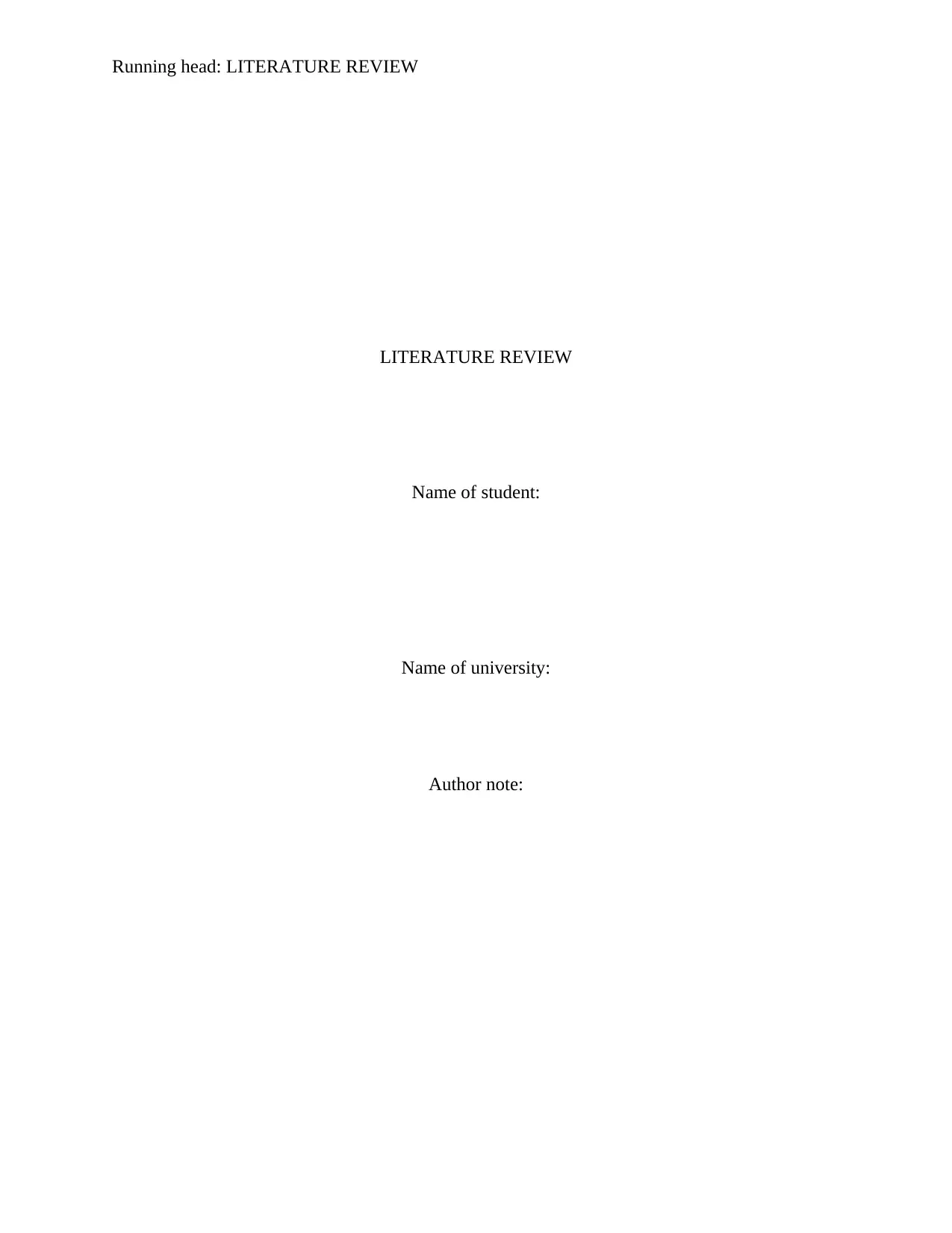
Running head: LITERATURE REVIEW
LITERATURE REVIEW
Name of student:
Name of university:
Author note:
LITERATURE REVIEW
Name of student:
Name of university:
Author note:
Paraphrase This Document
Need a fresh take? Get an instant paraphrase of this document with our AI Paraphraser
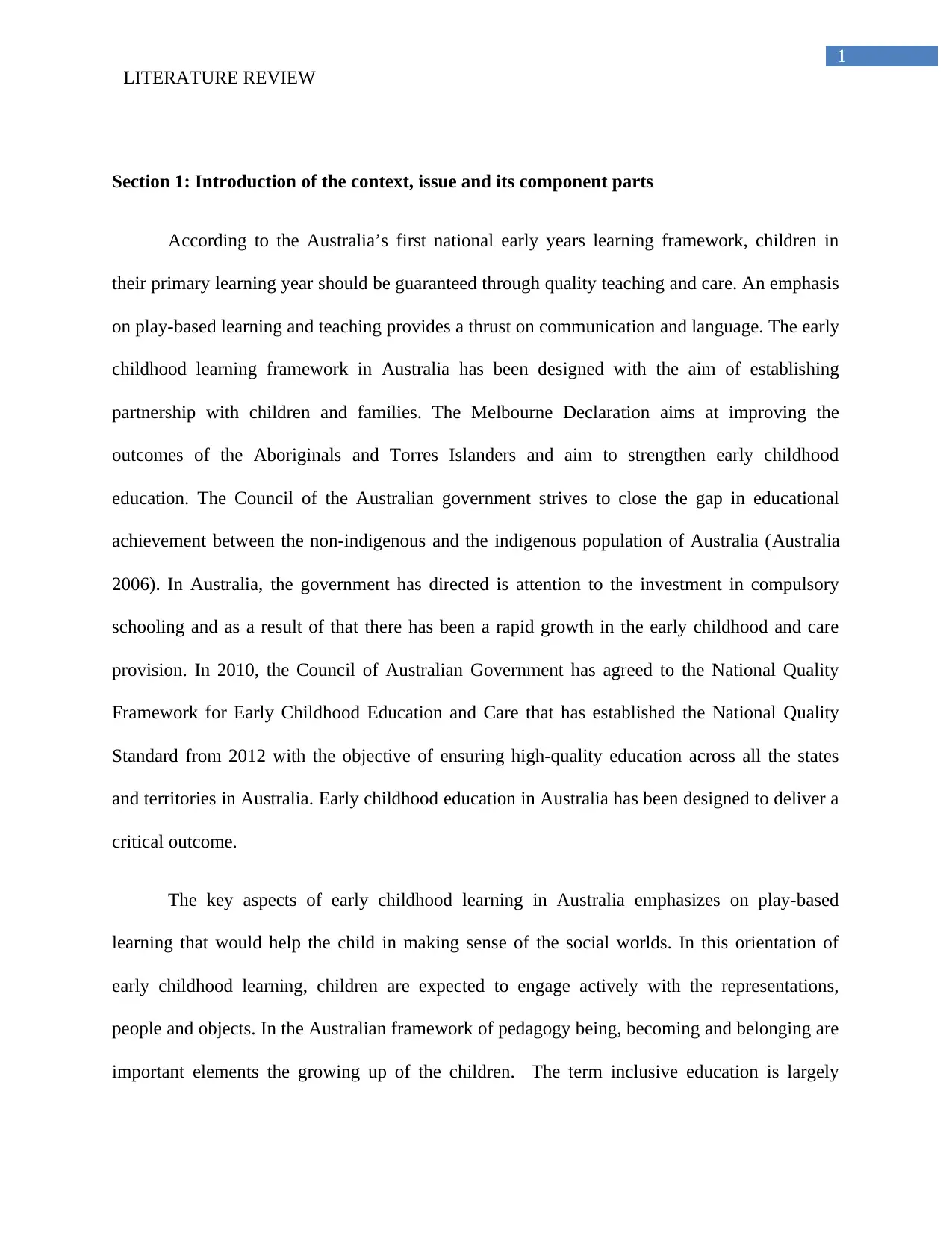
1
LITERATURE REVIEW
Section 1: Introduction of the context, issue and its component parts
According to the Australia’s first national early years learning framework, children in
their primary learning year should be guaranteed through quality teaching and care. An emphasis
on play-based learning and teaching provides a thrust on communication and language. The early
childhood learning framework in Australia has been designed with the aim of establishing
partnership with children and families. The Melbourne Declaration aims at improving the
outcomes of the Aboriginals and Torres Islanders and aim to strengthen early childhood
education. The Council of the Australian government strives to close the gap in educational
achievement between the non-indigenous and the indigenous population of Australia (Australia
2006). In Australia, the government has directed is attention to the investment in compulsory
schooling and as a result of that there has been a rapid growth in the early childhood and care
provision. In 2010, the Council of Australian Government has agreed to the National Quality
Framework for Early Childhood Education and Care that has established the National Quality
Standard from 2012 with the objective of ensuring high-quality education across all the states
and territories in Australia. Early childhood education in Australia has been designed to deliver a
critical outcome.
The key aspects of early childhood learning in Australia emphasizes on play-based
learning that would help the child in making sense of the social worlds. In this orientation of
early childhood learning, children are expected to engage actively with the representations,
people and objects. In the Australian framework of pedagogy being, becoming and belonging are
important elements the growing up of the children. The term inclusive education is largely
LITERATURE REVIEW
Section 1: Introduction of the context, issue and its component parts
According to the Australia’s first national early years learning framework, children in
their primary learning year should be guaranteed through quality teaching and care. An emphasis
on play-based learning and teaching provides a thrust on communication and language. The early
childhood learning framework in Australia has been designed with the aim of establishing
partnership with children and families. The Melbourne Declaration aims at improving the
outcomes of the Aboriginals and Torres Islanders and aim to strengthen early childhood
education. The Council of the Australian government strives to close the gap in educational
achievement between the non-indigenous and the indigenous population of Australia (Australia
2006). In Australia, the government has directed is attention to the investment in compulsory
schooling and as a result of that there has been a rapid growth in the early childhood and care
provision. In 2010, the Council of Australian Government has agreed to the National Quality
Framework for Early Childhood Education and Care that has established the National Quality
Standard from 2012 with the objective of ensuring high-quality education across all the states
and territories in Australia. Early childhood education in Australia has been designed to deliver a
critical outcome.
The key aspects of early childhood learning in Australia emphasizes on play-based
learning that would help the child in making sense of the social worlds. In this orientation of
early childhood learning, children are expected to engage actively with the representations,
people and objects. In the Australian framework of pedagogy being, becoming and belonging are
important elements the growing up of the children. The term inclusive education is largely
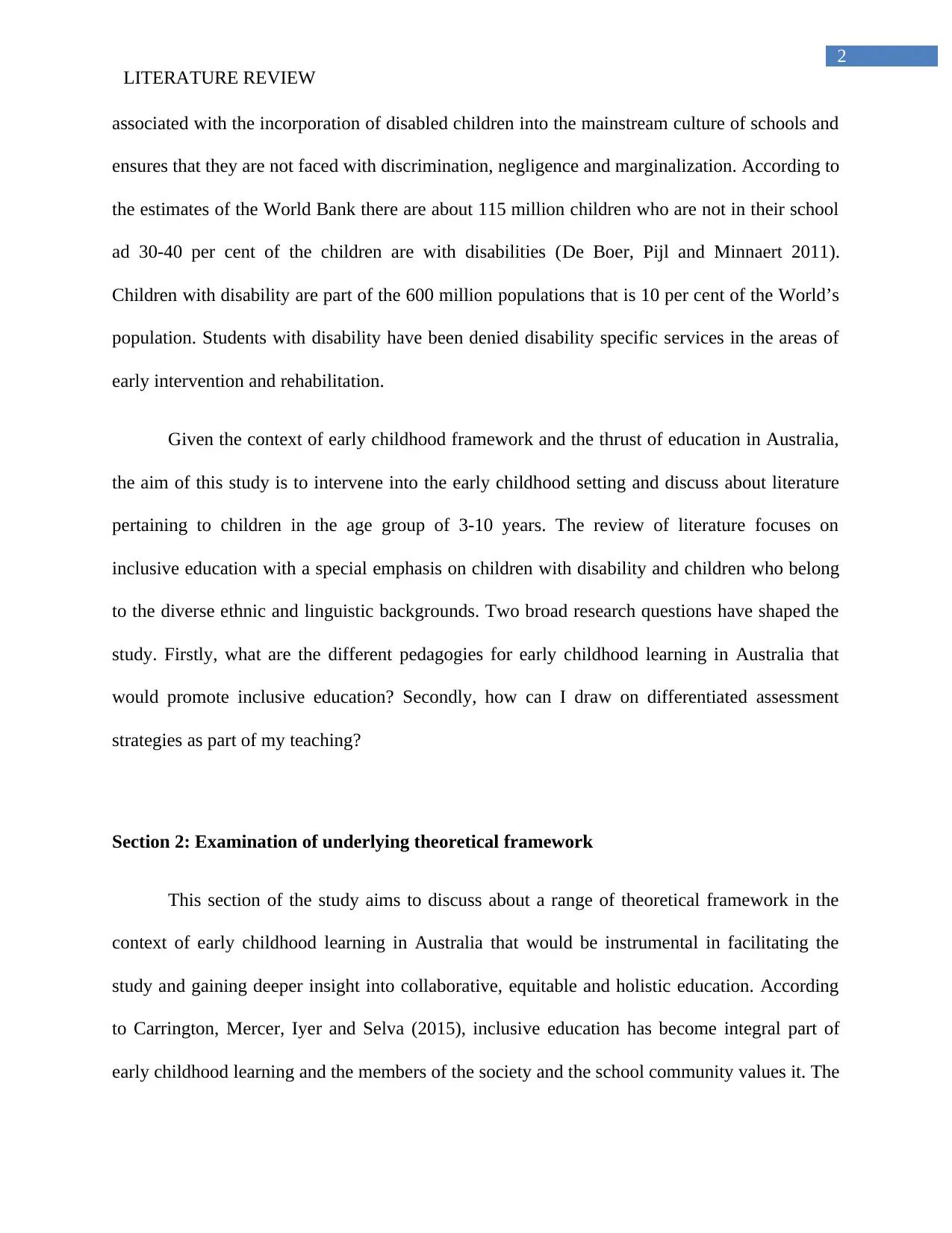
2
LITERATURE REVIEW
associated with the incorporation of disabled children into the mainstream culture of schools and
ensures that they are not faced with discrimination, negligence and marginalization. According to
the estimates of the World Bank there are about 115 million children who are not in their school
ad 30-40 per cent of the children are with disabilities (De Boer, Pijl and Minnaert 2011).
Children with disability are part of the 600 million populations that is 10 per cent of the World’s
population. Students with disability have been denied disability specific services in the areas of
early intervention and rehabilitation.
Given the context of early childhood framework and the thrust of education in Australia,
the aim of this study is to intervene into the early childhood setting and discuss about literature
pertaining to children in the age group of 3-10 years. The review of literature focuses on
inclusive education with a special emphasis on children with disability and children who belong
to the diverse ethnic and linguistic backgrounds. Two broad research questions have shaped the
study. Firstly, what are the different pedagogies for early childhood learning in Australia that
would promote inclusive education? Secondly, how can I draw on differentiated assessment
strategies as part of my teaching?
Section 2: Examination of underlying theoretical framework
This section of the study aims to discuss about a range of theoretical framework in the
context of early childhood learning in Australia that would be instrumental in facilitating the
study and gaining deeper insight into collaborative, equitable and holistic education. According
to Carrington, Mercer, Iyer and Selva (2015), inclusive education has become integral part of
early childhood learning and the members of the society and the school community values it. The
LITERATURE REVIEW
associated with the incorporation of disabled children into the mainstream culture of schools and
ensures that they are not faced with discrimination, negligence and marginalization. According to
the estimates of the World Bank there are about 115 million children who are not in their school
ad 30-40 per cent of the children are with disabilities (De Boer, Pijl and Minnaert 2011).
Children with disability are part of the 600 million populations that is 10 per cent of the World’s
population. Students with disability have been denied disability specific services in the areas of
early intervention and rehabilitation.
Given the context of early childhood framework and the thrust of education in Australia,
the aim of this study is to intervene into the early childhood setting and discuss about literature
pertaining to children in the age group of 3-10 years. The review of literature focuses on
inclusive education with a special emphasis on children with disability and children who belong
to the diverse ethnic and linguistic backgrounds. Two broad research questions have shaped the
study. Firstly, what are the different pedagogies for early childhood learning in Australia that
would promote inclusive education? Secondly, how can I draw on differentiated assessment
strategies as part of my teaching?
Section 2: Examination of underlying theoretical framework
This section of the study aims to discuss about a range of theoretical framework in the
context of early childhood learning in Australia that would be instrumental in facilitating the
study and gaining deeper insight into collaborative, equitable and holistic education. According
to Carrington, Mercer, Iyer and Selva (2015), inclusive education has become integral part of
early childhood learning and the members of the society and the school community values it. The
⊘ This is a preview!⊘
Do you want full access?
Subscribe today to unlock all pages.

Trusted by 1+ million students worldwide
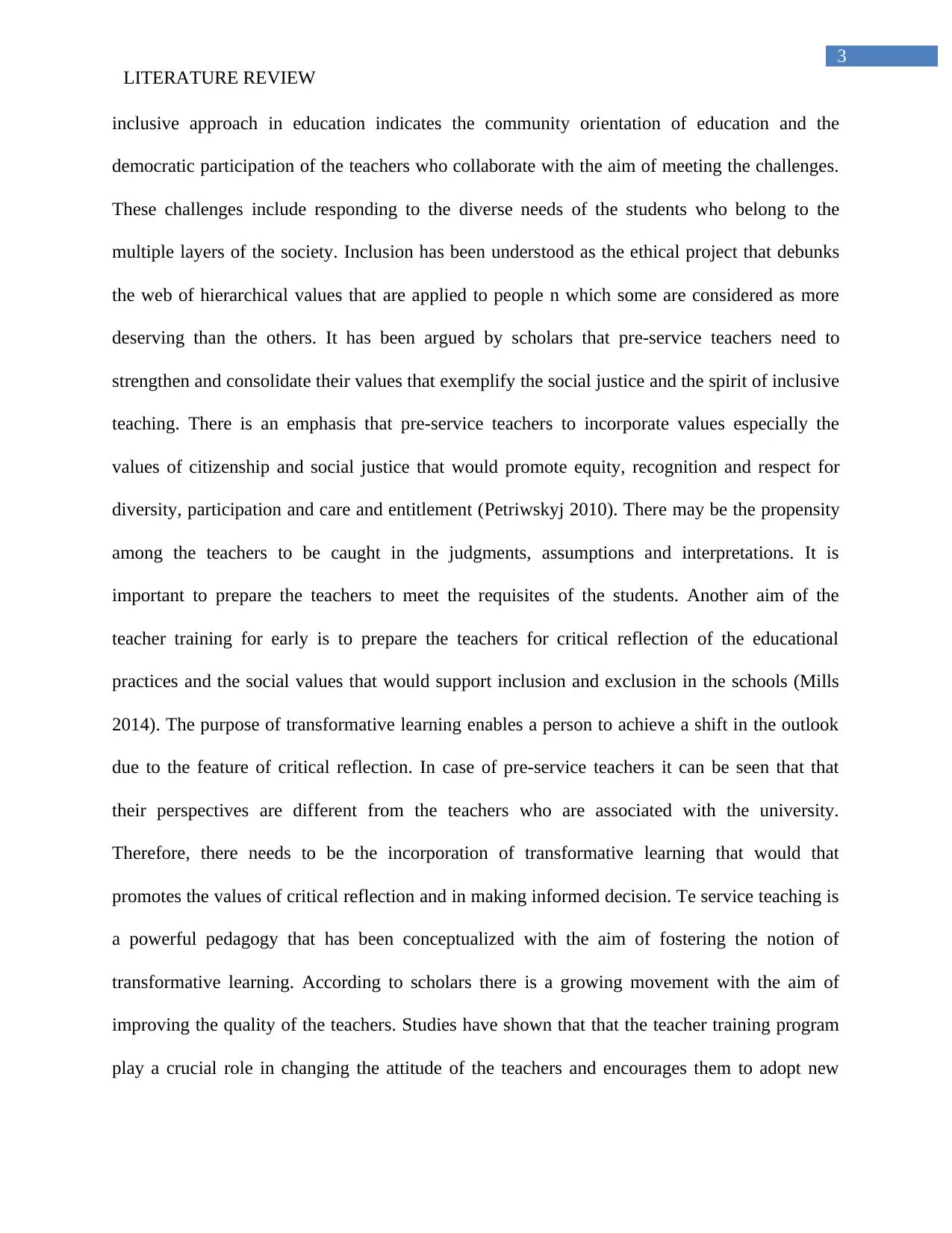
3
LITERATURE REVIEW
inclusive approach in education indicates the community orientation of education and the
democratic participation of the teachers who collaborate with the aim of meeting the challenges.
These challenges include responding to the diverse needs of the students who belong to the
multiple layers of the society. Inclusion has been understood as the ethical project that debunks
the web of hierarchical values that are applied to people n which some are considered as more
deserving than the others. It has been argued by scholars that pre-service teachers need to
strengthen and consolidate their values that exemplify the social justice and the spirit of inclusive
teaching. There is an emphasis that pre-service teachers to incorporate values especially the
values of citizenship and social justice that would promote equity, recognition and respect for
diversity, participation and care and entitlement (Petriwskyj 2010). There may be the propensity
among the teachers to be caught in the judgments, assumptions and interpretations. It is
important to prepare the teachers to meet the requisites of the students. Another aim of the
teacher training for early is to prepare the teachers for critical reflection of the educational
practices and the social values that would support inclusion and exclusion in the schools (Mills
2014). The purpose of transformative learning enables a person to achieve a shift in the outlook
due to the feature of critical reflection. In case of pre-service teachers it can be seen that that
their perspectives are different from the teachers who are associated with the university.
Therefore, there needs to be the incorporation of transformative learning that would that
promotes the values of critical reflection and in making informed decision. Te service teaching is
a powerful pedagogy that has been conceptualized with the aim of fostering the notion of
transformative learning. According to scholars there is a growing movement with the aim of
improving the quality of the teachers. Studies have shown that that the teacher training program
play a crucial role in changing the attitude of the teachers and encourages them to adopt new
LITERATURE REVIEW
inclusive approach in education indicates the community orientation of education and the
democratic participation of the teachers who collaborate with the aim of meeting the challenges.
These challenges include responding to the diverse needs of the students who belong to the
multiple layers of the society. Inclusion has been understood as the ethical project that debunks
the web of hierarchical values that are applied to people n which some are considered as more
deserving than the others. It has been argued by scholars that pre-service teachers need to
strengthen and consolidate their values that exemplify the social justice and the spirit of inclusive
teaching. There is an emphasis that pre-service teachers to incorporate values especially the
values of citizenship and social justice that would promote equity, recognition and respect for
diversity, participation and care and entitlement (Petriwskyj 2010). There may be the propensity
among the teachers to be caught in the judgments, assumptions and interpretations. It is
important to prepare the teachers to meet the requisites of the students. Another aim of the
teacher training for early is to prepare the teachers for critical reflection of the educational
practices and the social values that would support inclusion and exclusion in the schools (Mills
2014). The purpose of transformative learning enables a person to achieve a shift in the outlook
due to the feature of critical reflection. In case of pre-service teachers it can be seen that that
their perspectives are different from the teachers who are associated with the university.
Therefore, there needs to be the incorporation of transformative learning that would that
promotes the values of critical reflection and in making informed decision. Te service teaching is
a powerful pedagogy that has been conceptualized with the aim of fostering the notion of
transformative learning. According to scholars there is a growing movement with the aim of
improving the quality of the teachers. Studies have shown that that the teacher training program
play a crucial role in changing the attitude of the teachers and encourages them to adopt new
Paraphrase This Document
Need a fresh take? Get an instant paraphrase of this document with our AI Paraphraser
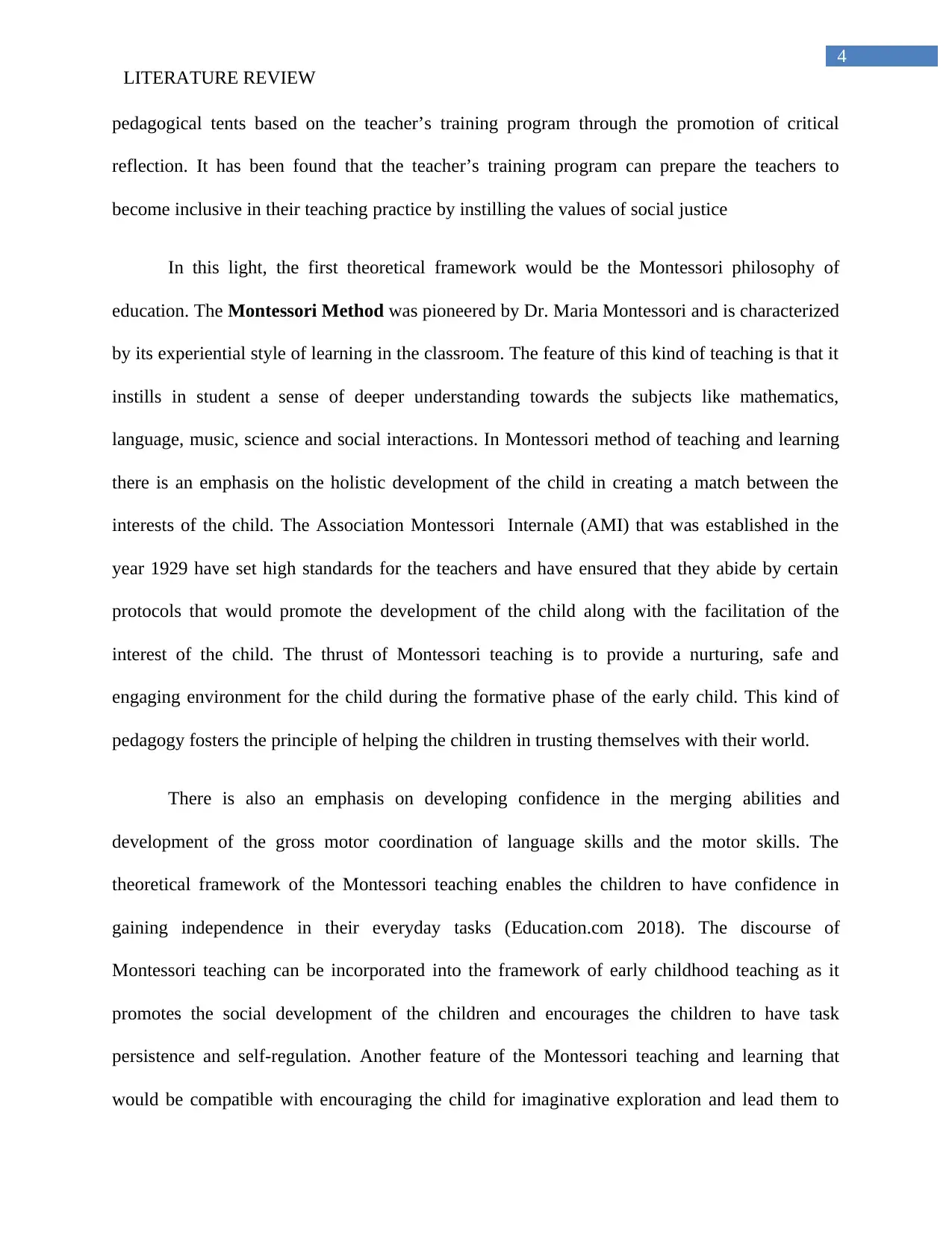
4
LITERATURE REVIEW
pedagogical tents based on the teacher’s training program through the promotion of critical
reflection. It has been found that the teacher’s training program can prepare the teachers to
become inclusive in their teaching practice by instilling the values of social justice
In this light, the first theoretical framework would be the Montessori philosophy of
education. The Montessori Method was pioneered by Dr. Maria Montessori and is characterized
by its experiential style of learning in the classroom. The feature of this kind of teaching is that it
instills in student a sense of deeper understanding towards the subjects like mathematics,
language, music, science and social interactions. In Montessori method of teaching and learning
there is an emphasis on the holistic development of the child in creating a match between the
interests of the child. The Association Montessori Internale (AMI) that was established in the
year 1929 have set high standards for the teachers and have ensured that they abide by certain
protocols that would promote the development of the child along with the facilitation of the
interest of the child. The thrust of Montessori teaching is to provide a nurturing, safe and
engaging environment for the child during the formative phase of the early child. This kind of
pedagogy fosters the principle of helping the children in trusting themselves with their world.
There is also an emphasis on developing confidence in the merging abilities and
development of the gross motor coordination of language skills and the motor skills. The
theoretical framework of the Montessori teaching enables the children to have confidence in
gaining independence in their everyday tasks (Education.com 2018). The discourse of
Montessori teaching can be incorporated into the framework of early childhood teaching as it
promotes the social development of the children and encourages the children to have task
persistence and self-regulation. Another feature of the Montessori teaching and learning that
would be compatible with encouraging the child for imaginative exploration and lead them to
LITERATURE REVIEW
pedagogical tents based on the teacher’s training program through the promotion of critical
reflection. It has been found that the teacher’s training program can prepare the teachers to
become inclusive in their teaching practice by instilling the values of social justice
In this light, the first theoretical framework would be the Montessori philosophy of
education. The Montessori Method was pioneered by Dr. Maria Montessori and is characterized
by its experiential style of learning in the classroom. The feature of this kind of teaching is that it
instills in student a sense of deeper understanding towards the subjects like mathematics,
language, music, science and social interactions. In Montessori method of teaching and learning
there is an emphasis on the holistic development of the child in creating a match between the
interests of the child. The Association Montessori Internale (AMI) that was established in the
year 1929 have set high standards for the teachers and have ensured that they abide by certain
protocols that would promote the development of the child along with the facilitation of the
interest of the child. The thrust of Montessori teaching is to provide a nurturing, safe and
engaging environment for the child during the formative phase of the early child. This kind of
pedagogy fosters the principle of helping the children in trusting themselves with their world.
There is also an emphasis on developing confidence in the merging abilities and
development of the gross motor coordination of language skills and the motor skills. The
theoretical framework of the Montessori teaching enables the children to have confidence in
gaining independence in their everyday tasks (Education.com 2018). The discourse of
Montessori teaching can be incorporated into the framework of early childhood teaching as it
promotes the social development of the children and encourages the children to have task
persistence and self-regulation. Another feature of the Montessori teaching and learning that
would be compatible with encouraging the child for imaginative exploration and lead them to
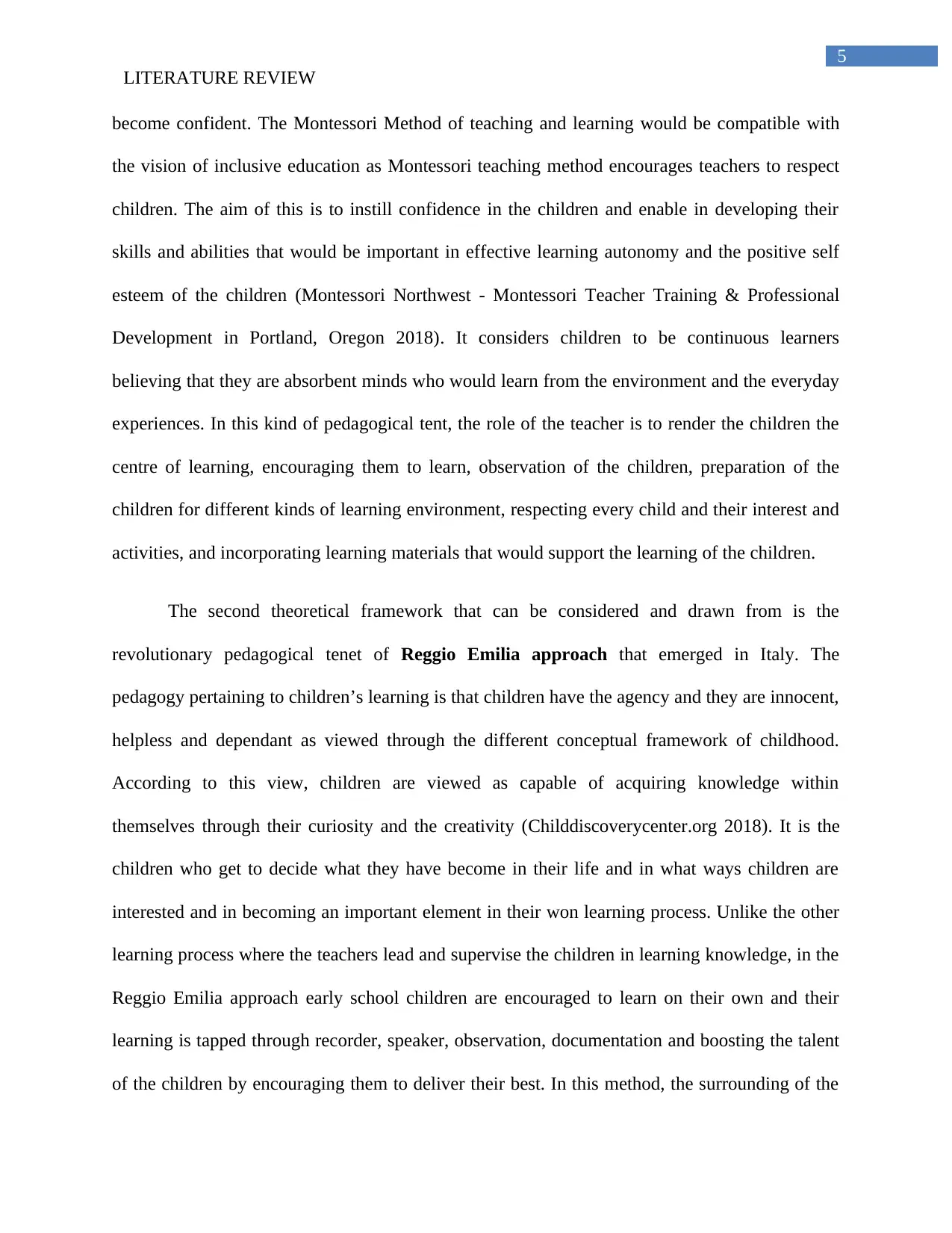
5
LITERATURE REVIEW
become confident. The Montessori Method of teaching and learning would be compatible with
the vision of inclusive education as Montessori teaching method encourages teachers to respect
children. The aim of this is to instill confidence in the children and enable in developing their
skills and abilities that would be important in effective learning autonomy and the positive self
esteem of the children (Montessori Northwest - Montessori Teacher Training & Professional
Development in Portland, Oregon 2018). It considers children to be continuous learners
believing that they are absorbent minds who would learn from the environment and the everyday
experiences. In this kind of pedagogical tent, the role of the teacher is to render the children the
centre of learning, encouraging them to learn, observation of the children, preparation of the
children for different kinds of learning environment, respecting every child and their interest and
activities, and incorporating learning materials that would support the learning of the children.
The second theoretical framework that can be considered and drawn from is the
revolutionary pedagogical tenet of Reggio Emilia approach that emerged in Italy. The
pedagogy pertaining to children’s learning is that children have the agency and they are innocent,
helpless and dependant as viewed through the different conceptual framework of childhood.
According to this view, children are viewed as capable of acquiring knowledge within
themselves through their curiosity and the creativity (Childdiscoverycenter.org 2018). It is the
children who get to decide what they have become in their life and in what ways children are
interested and in becoming an important element in their won learning process. Unlike the other
learning process where the teachers lead and supervise the children in learning knowledge, in the
Reggio Emilia approach early school children are encouraged to learn on their own and their
learning is tapped through recorder, speaker, observation, documentation and boosting the talent
of the children by encouraging them to deliver their best. In this method, the surrounding of the
LITERATURE REVIEW
become confident. The Montessori Method of teaching and learning would be compatible with
the vision of inclusive education as Montessori teaching method encourages teachers to respect
children. The aim of this is to instill confidence in the children and enable in developing their
skills and abilities that would be important in effective learning autonomy and the positive self
esteem of the children (Montessori Northwest - Montessori Teacher Training & Professional
Development in Portland, Oregon 2018). It considers children to be continuous learners
believing that they are absorbent minds who would learn from the environment and the everyday
experiences. In this kind of pedagogical tent, the role of the teacher is to render the children the
centre of learning, encouraging them to learn, observation of the children, preparation of the
children for different kinds of learning environment, respecting every child and their interest and
activities, and incorporating learning materials that would support the learning of the children.
The second theoretical framework that can be considered and drawn from is the
revolutionary pedagogical tenet of Reggio Emilia approach that emerged in Italy. The
pedagogy pertaining to children’s learning is that children have the agency and they are innocent,
helpless and dependant as viewed through the different conceptual framework of childhood.
According to this view, children are viewed as capable of acquiring knowledge within
themselves through their curiosity and the creativity (Childdiscoverycenter.org 2018). It is the
children who get to decide what they have become in their life and in what ways children are
interested and in becoming an important element in their won learning process. Unlike the other
learning process where the teachers lead and supervise the children in learning knowledge, in the
Reggio Emilia approach early school children are encouraged to learn on their own and their
learning is tapped through recorder, speaker, observation, documentation and boosting the talent
of the children by encouraging them to deliver their best. In this method, the surrounding of the
⊘ This is a preview!⊘
Do you want full access?
Subscribe today to unlock all pages.

Trusted by 1+ million students worldwide
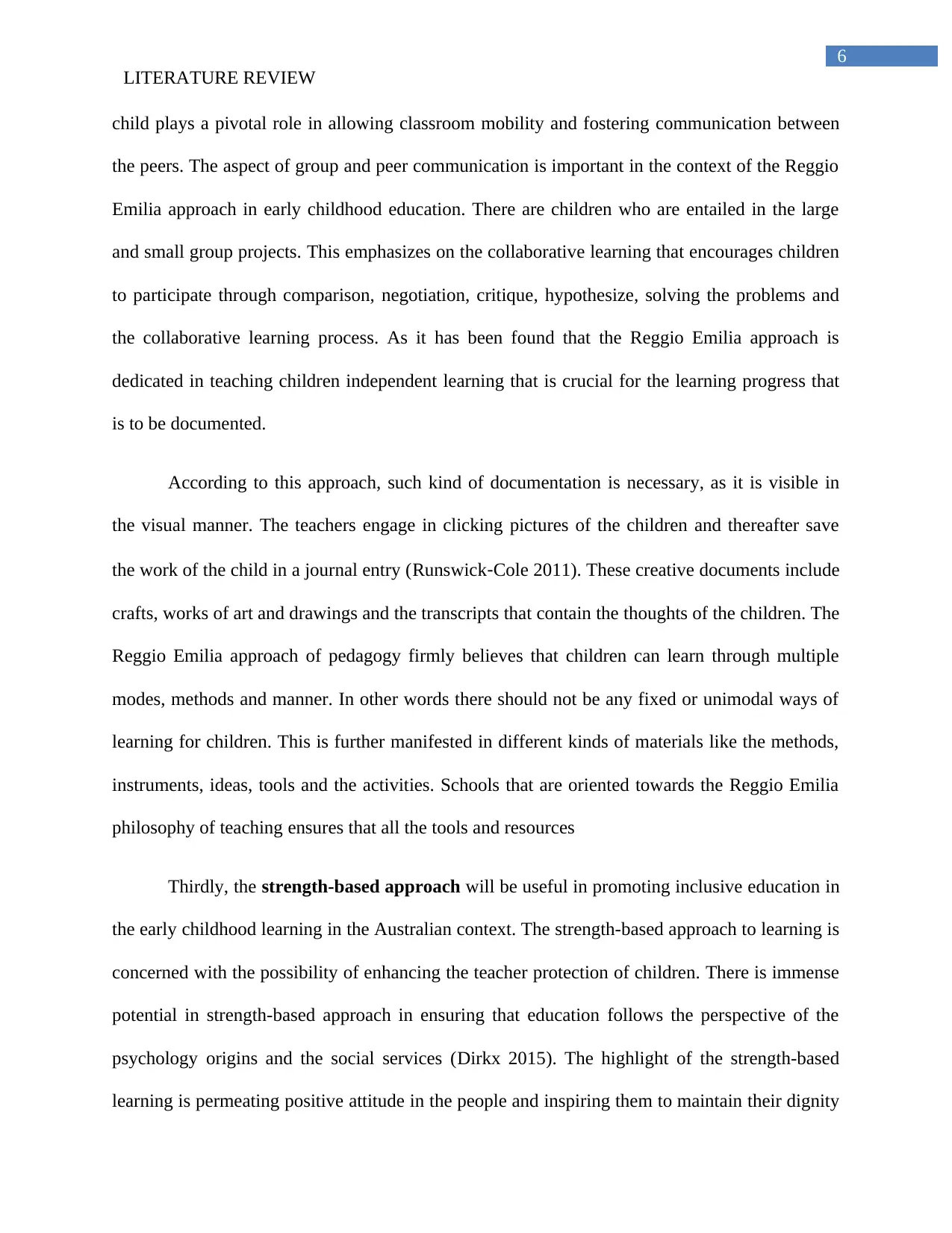
6
LITERATURE REVIEW
child plays a pivotal role in allowing classroom mobility and fostering communication between
the peers. The aspect of group and peer communication is important in the context of the Reggio
Emilia approach in early childhood education. There are children who are entailed in the large
and small group projects. This emphasizes on the collaborative learning that encourages children
to participate through comparison, negotiation, critique, hypothesize, solving the problems and
the collaborative learning process. As it has been found that the Reggio Emilia approach is
dedicated in teaching children independent learning that is crucial for the learning progress that
is to be documented.
According to this approach, such kind of documentation is necessary, as it is visible in
the visual manner. The teachers engage in clicking pictures of the children and thereafter save
the work of the child in a journal entry (Runswick‐Cole 2011). These creative documents include
crafts, works of art and drawings and the transcripts that contain the thoughts of the children. The
Reggio Emilia approach of pedagogy firmly believes that children can learn through multiple
modes, methods and manner. In other words there should not be any fixed or unimodal ways of
learning for children. This is further manifested in different kinds of materials like the methods,
instruments, ideas, tools and the activities. Schools that are oriented towards the Reggio Emilia
philosophy of teaching ensures that all the tools and resources
Thirdly, the strength-based approach will be useful in promoting inclusive education in
the early childhood learning in the Australian context. The strength-based approach to learning is
concerned with the possibility of enhancing the teacher protection of children. There is immense
potential in strength-based approach in ensuring that education follows the perspective of the
psychology origins and the social services (Dirkx 2015). The highlight of the strength-based
learning is permeating positive attitude in the people and inspiring them to maintain their dignity
LITERATURE REVIEW
child plays a pivotal role in allowing classroom mobility and fostering communication between
the peers. The aspect of group and peer communication is important in the context of the Reggio
Emilia approach in early childhood education. There are children who are entailed in the large
and small group projects. This emphasizes on the collaborative learning that encourages children
to participate through comparison, negotiation, critique, hypothesize, solving the problems and
the collaborative learning process. As it has been found that the Reggio Emilia approach is
dedicated in teaching children independent learning that is crucial for the learning progress that
is to be documented.
According to this approach, such kind of documentation is necessary, as it is visible in
the visual manner. The teachers engage in clicking pictures of the children and thereafter save
the work of the child in a journal entry (Runswick‐Cole 2011). These creative documents include
crafts, works of art and drawings and the transcripts that contain the thoughts of the children. The
Reggio Emilia approach of pedagogy firmly believes that children can learn through multiple
modes, methods and manner. In other words there should not be any fixed or unimodal ways of
learning for children. This is further manifested in different kinds of materials like the methods,
instruments, ideas, tools and the activities. Schools that are oriented towards the Reggio Emilia
philosophy of teaching ensures that all the tools and resources
Thirdly, the strength-based approach will be useful in promoting inclusive education in
the early childhood learning in the Australian context. The strength-based approach to learning is
concerned with the possibility of enhancing the teacher protection of children. There is immense
potential in strength-based approach in ensuring that education follows the perspective of the
psychology origins and the social services (Dirkx 2015). The highlight of the strength-based
learning is permeating positive attitude in the people and inspiring them to maintain their dignity
Paraphrase This Document
Need a fresh take? Get an instant paraphrase of this document with our AI Paraphraser
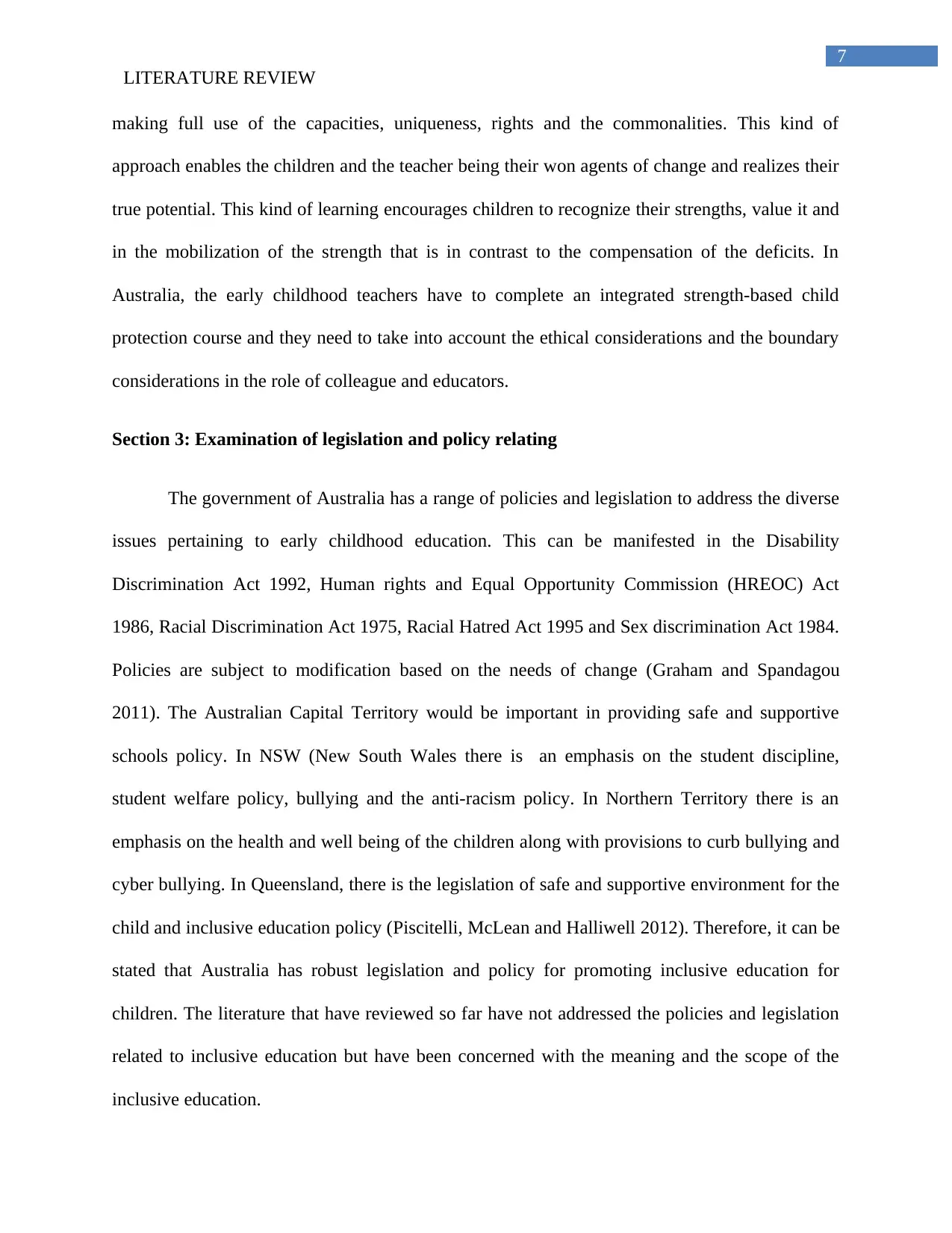
7
LITERATURE REVIEW
making full use of the capacities, uniqueness, rights and the commonalities. This kind of
approach enables the children and the teacher being their won agents of change and realizes their
true potential. This kind of learning encourages children to recognize their strengths, value it and
in the mobilization of the strength that is in contrast to the compensation of the deficits. In
Australia, the early childhood teachers have to complete an integrated strength-based child
protection course and they need to take into account the ethical considerations and the boundary
considerations in the role of colleague and educators.
Section 3: Examination of legislation and policy relating
The government of Australia has a range of policies and legislation to address the diverse
issues pertaining to early childhood education. This can be manifested in the Disability
Discrimination Act 1992, Human rights and Equal Opportunity Commission (HREOC) Act
1986, Racial Discrimination Act 1975, Racial Hatred Act 1995 and Sex discrimination Act 1984.
Policies are subject to modification based on the needs of change (Graham and Spandagou
2011). The Australian Capital Territory would be important in providing safe and supportive
schools policy. In NSW (New South Wales there is an emphasis on the student discipline,
student welfare policy, bullying and the anti-racism policy. In Northern Territory there is an
emphasis on the health and well being of the children along with provisions to curb bullying and
cyber bullying. In Queensland, there is the legislation of safe and supportive environment for the
child and inclusive education policy (Piscitelli, McLean and Halliwell 2012). Therefore, it can be
stated that Australia has robust legislation and policy for promoting inclusive education for
children. The literature that have reviewed so far have not addressed the policies and legislation
related to inclusive education but have been concerned with the meaning and the scope of the
inclusive education.
LITERATURE REVIEW
making full use of the capacities, uniqueness, rights and the commonalities. This kind of
approach enables the children and the teacher being their won agents of change and realizes their
true potential. This kind of learning encourages children to recognize their strengths, value it and
in the mobilization of the strength that is in contrast to the compensation of the deficits. In
Australia, the early childhood teachers have to complete an integrated strength-based child
protection course and they need to take into account the ethical considerations and the boundary
considerations in the role of colleague and educators.
Section 3: Examination of legislation and policy relating
The government of Australia has a range of policies and legislation to address the diverse
issues pertaining to early childhood education. This can be manifested in the Disability
Discrimination Act 1992, Human rights and Equal Opportunity Commission (HREOC) Act
1986, Racial Discrimination Act 1975, Racial Hatred Act 1995 and Sex discrimination Act 1984.
Policies are subject to modification based on the needs of change (Graham and Spandagou
2011). The Australian Capital Territory would be important in providing safe and supportive
schools policy. In NSW (New South Wales there is an emphasis on the student discipline,
student welfare policy, bullying and the anti-racism policy. In Northern Territory there is an
emphasis on the health and well being of the children along with provisions to curb bullying and
cyber bullying. In Queensland, there is the legislation of safe and supportive environment for the
child and inclusive education policy (Piscitelli, McLean and Halliwell 2012). Therefore, it can be
stated that Australia has robust legislation and policy for promoting inclusive education for
children. The literature that have reviewed so far have not addressed the policies and legislation
related to inclusive education but have been concerned with the meaning and the scope of the
inclusive education.
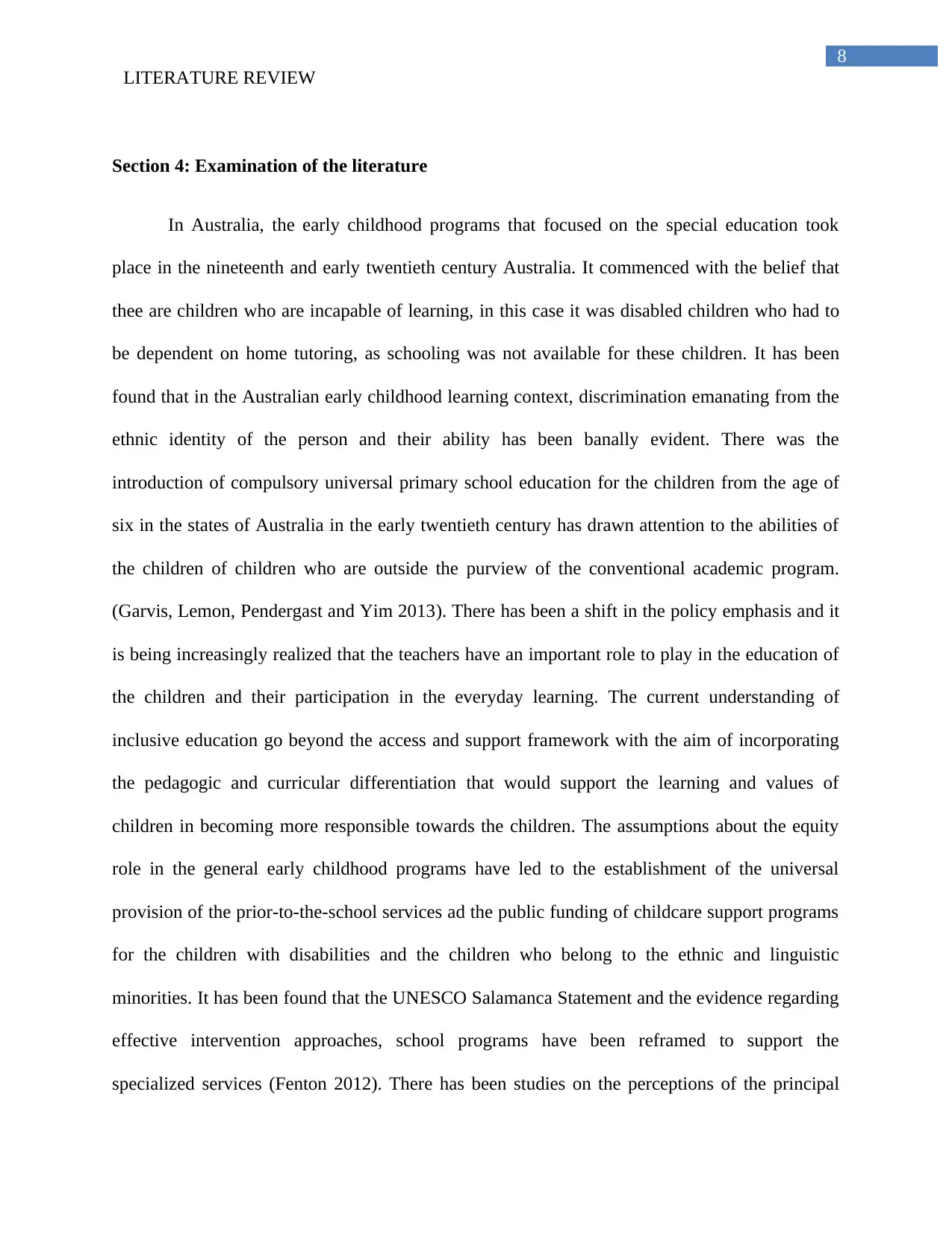
8
LITERATURE REVIEW
Section 4: Examination of the literature
In Australia, the early childhood programs that focused on the special education took
place in the nineteenth and early twentieth century Australia. It commenced with the belief that
thee are children who are incapable of learning, in this case it was disabled children who had to
be dependent on home tutoring, as schooling was not available for these children. It has been
found that in the Australian early childhood learning context, discrimination emanating from the
ethnic identity of the person and their ability has been banally evident. There was the
introduction of compulsory universal primary school education for the children from the age of
six in the states of Australia in the early twentieth century has drawn attention to the abilities of
the children of children who are outside the purview of the conventional academic program.
(Garvis, Lemon, Pendergast and Yim 2013). There has been a shift in the policy emphasis and it
is being increasingly realized that the teachers have an important role to play in the education of
the children and their participation in the everyday learning. The current understanding of
inclusive education go beyond the access and support framework with the aim of incorporating
the pedagogic and curricular differentiation that would support the learning and values of
children in becoming more responsible towards the children. The assumptions about the equity
role in the general early childhood programs have led to the establishment of the universal
provision of the prior-to-the-school services ad the public funding of childcare support programs
for the children with disabilities and the children who belong to the ethnic and linguistic
minorities. It has been found that the UNESCO Salamanca Statement and the evidence regarding
effective intervention approaches, school programs have been reframed to support the
specialized services (Fenton 2012). There has been studies on the perceptions of the principal
LITERATURE REVIEW
Section 4: Examination of the literature
In Australia, the early childhood programs that focused on the special education took
place in the nineteenth and early twentieth century Australia. It commenced with the belief that
thee are children who are incapable of learning, in this case it was disabled children who had to
be dependent on home tutoring, as schooling was not available for these children. It has been
found that in the Australian early childhood learning context, discrimination emanating from the
ethnic identity of the person and their ability has been banally evident. There was the
introduction of compulsory universal primary school education for the children from the age of
six in the states of Australia in the early twentieth century has drawn attention to the abilities of
the children of children who are outside the purview of the conventional academic program.
(Garvis, Lemon, Pendergast and Yim 2013). There has been a shift in the policy emphasis and it
is being increasingly realized that the teachers have an important role to play in the education of
the children and their participation in the everyday learning. The current understanding of
inclusive education go beyond the access and support framework with the aim of incorporating
the pedagogic and curricular differentiation that would support the learning and values of
children in becoming more responsible towards the children. The assumptions about the equity
role in the general early childhood programs have led to the establishment of the universal
provision of the prior-to-the-school services ad the public funding of childcare support programs
for the children with disabilities and the children who belong to the ethnic and linguistic
minorities. It has been found that the UNESCO Salamanca Statement and the evidence regarding
effective intervention approaches, school programs have been reframed to support the
specialized services (Fenton 2012). There has been studies on the perceptions of the principal
⊘ This is a preview!⊘
Do you want full access?
Subscribe today to unlock all pages.

Trusted by 1+ million students worldwide
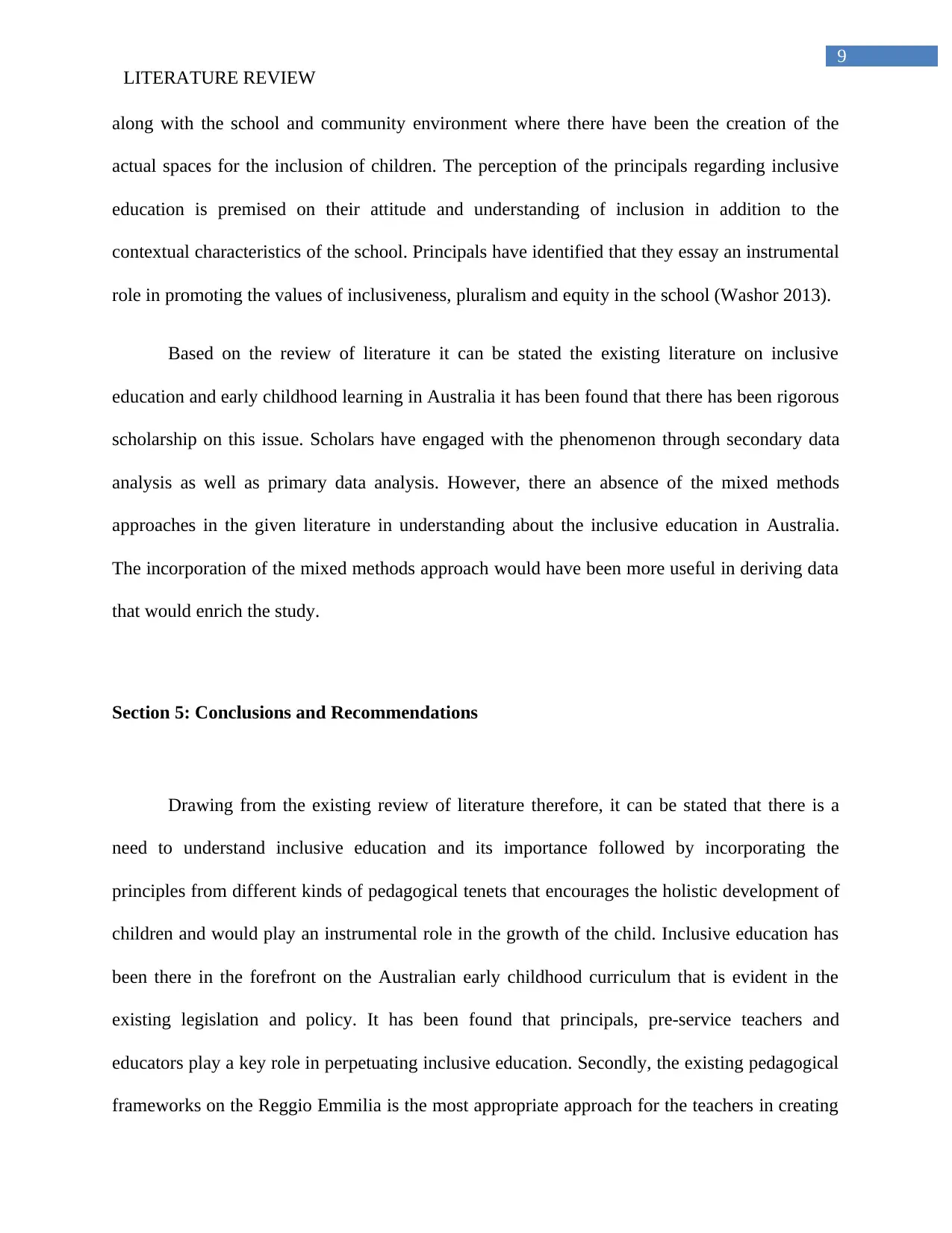
9
LITERATURE REVIEW
along with the school and community environment where there have been the creation of the
actual spaces for the inclusion of children. The perception of the principals regarding inclusive
education is premised on their attitude and understanding of inclusion in addition to the
contextual characteristics of the school. Principals have identified that they essay an instrumental
role in promoting the values of inclusiveness, pluralism and equity in the school (Washor 2013).
Based on the review of literature it can be stated the existing literature on inclusive
education and early childhood learning in Australia it has been found that there has been rigorous
scholarship on this issue. Scholars have engaged with the phenomenon through secondary data
analysis as well as primary data analysis. However, there an absence of the mixed methods
approaches in the given literature in understanding about the inclusive education in Australia.
The incorporation of the mixed methods approach would have been more useful in deriving data
that would enrich the study.
Section 5: Conclusions and Recommendations
Drawing from the existing review of literature therefore, it can be stated that there is a
need to understand inclusive education and its importance followed by incorporating the
principles from different kinds of pedagogical tenets that encourages the holistic development of
children and would play an instrumental role in the growth of the child. Inclusive education has
been there in the forefront on the Australian early childhood curriculum that is evident in the
existing legislation and policy. It has been found that principals, pre-service teachers and
educators play a key role in perpetuating inclusive education. Secondly, the existing pedagogical
frameworks on the Reggio Emmilia is the most appropriate approach for the teachers in creating
LITERATURE REVIEW
along with the school and community environment where there have been the creation of the
actual spaces for the inclusion of children. The perception of the principals regarding inclusive
education is premised on their attitude and understanding of inclusion in addition to the
contextual characteristics of the school. Principals have identified that they essay an instrumental
role in promoting the values of inclusiveness, pluralism and equity in the school (Washor 2013).
Based on the review of literature it can be stated the existing literature on inclusive
education and early childhood learning in Australia it has been found that there has been rigorous
scholarship on this issue. Scholars have engaged with the phenomenon through secondary data
analysis as well as primary data analysis. However, there an absence of the mixed methods
approaches in the given literature in understanding about the inclusive education in Australia.
The incorporation of the mixed methods approach would have been more useful in deriving data
that would enrich the study.
Section 5: Conclusions and Recommendations
Drawing from the existing review of literature therefore, it can be stated that there is a
need to understand inclusive education and its importance followed by incorporating the
principles from different kinds of pedagogical tenets that encourages the holistic development of
children and would play an instrumental role in the growth of the child. Inclusive education has
been there in the forefront on the Australian early childhood curriculum that is evident in the
existing legislation and policy. It has been found that principals, pre-service teachers and
educators play a key role in perpetuating inclusive education. Secondly, the existing pedagogical
frameworks on the Reggio Emmilia is the most appropriate approach for the teachers in creating
Paraphrase This Document
Need a fresh take? Get an instant paraphrase of this document with our AI Paraphraser
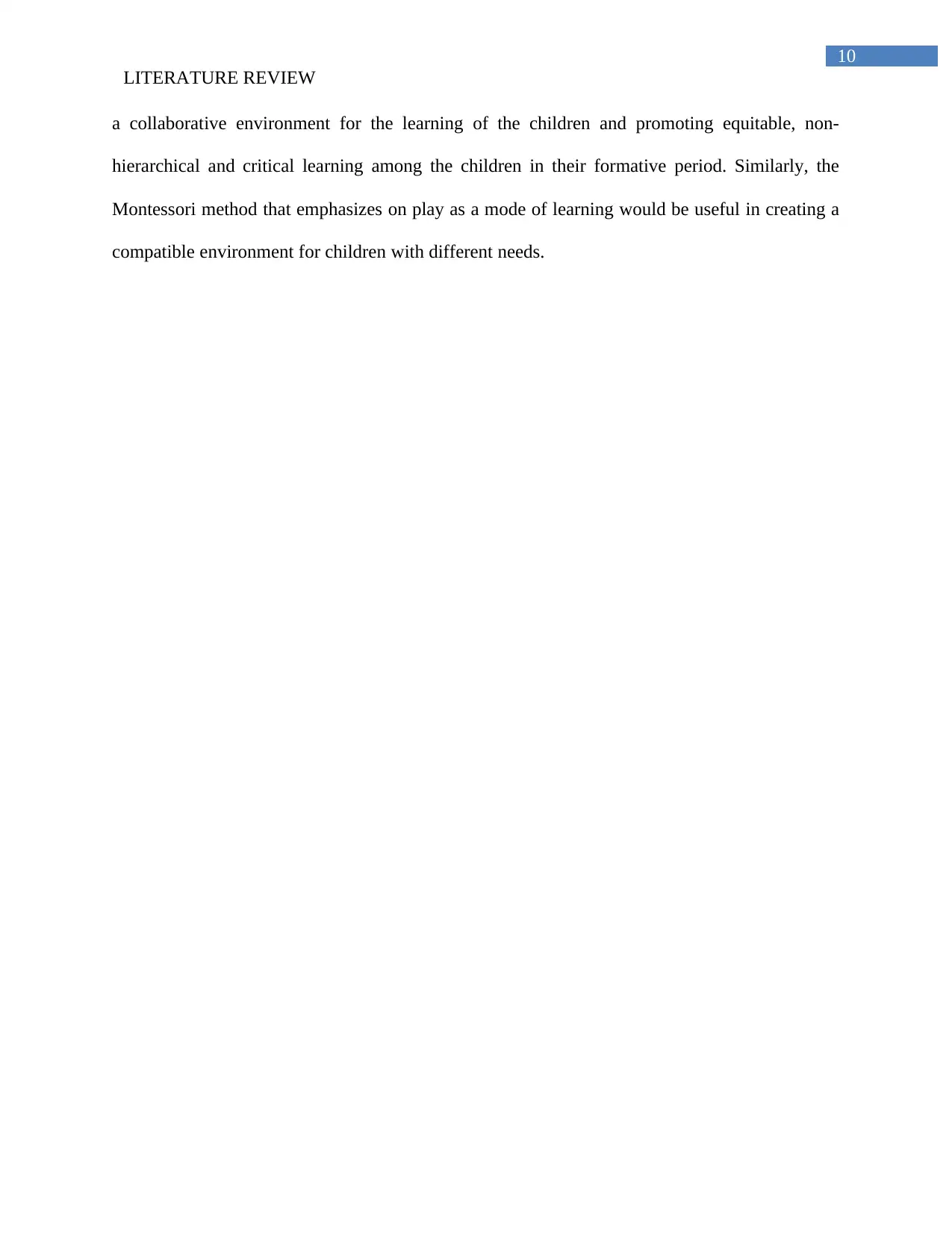
10
LITERATURE REVIEW
a collaborative environment for the learning of the children and promoting equitable, non-
hierarchical and critical learning among the children in their formative period. Similarly, the
Montessori method that emphasizes on play as a mode of learning would be useful in creating a
compatible environment for children with different needs.
LITERATURE REVIEW
a collaborative environment for the learning of the children and promoting equitable, non-
hierarchical and critical learning among the children in their formative period. Similarly, the
Montessori method that emphasizes on play as a mode of learning would be useful in creating a
compatible environment for children with different needs.
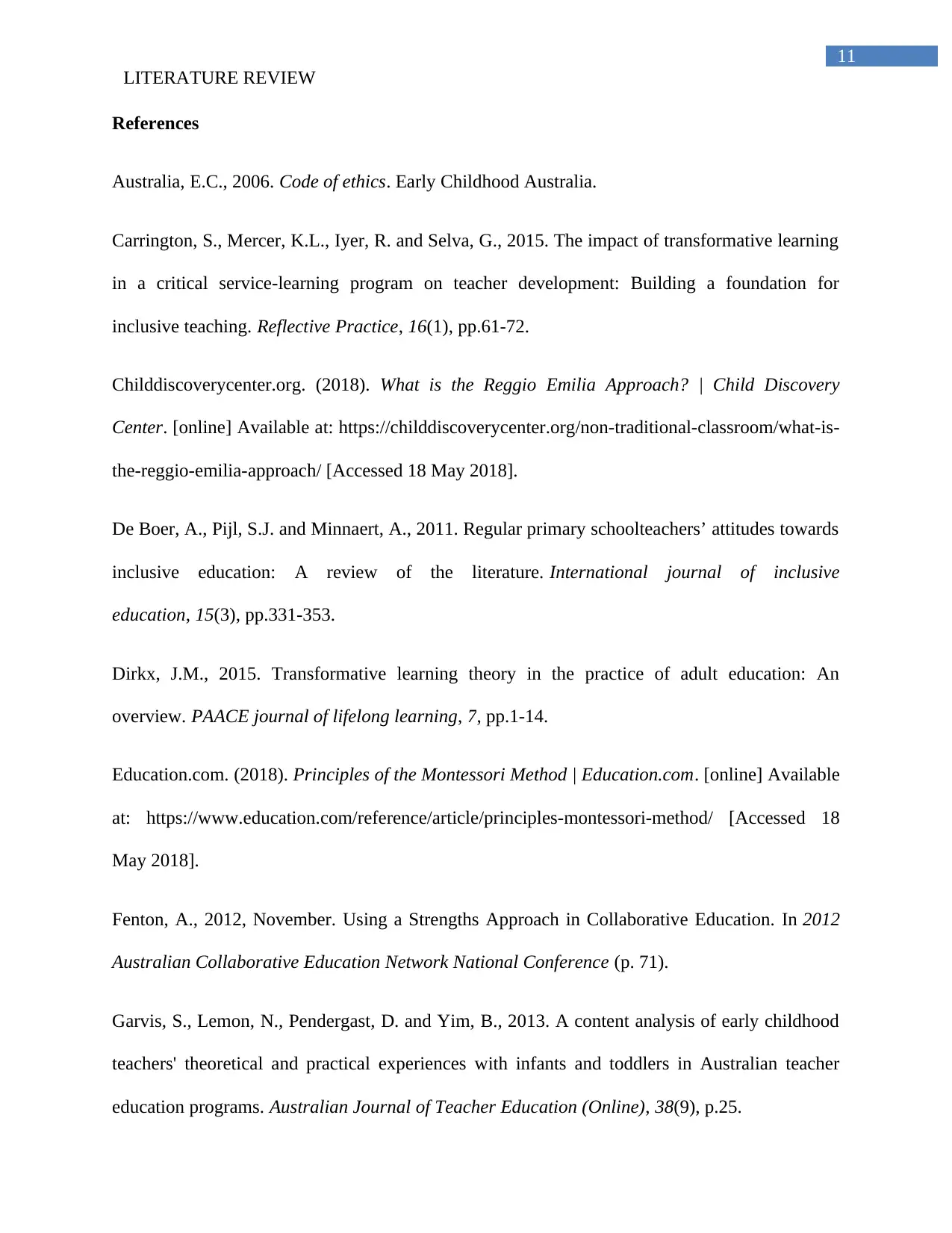
11
LITERATURE REVIEW
References
Australia, E.C., 2006. Code of ethics. Early Childhood Australia.
Carrington, S., Mercer, K.L., Iyer, R. and Selva, G., 2015. The impact of transformative learning
in a critical service-learning program on teacher development: Building a foundation for
inclusive teaching. Reflective Practice, 16(1), pp.61-72.
Childdiscoverycenter.org. (2018). What is the Reggio Emilia Approach? | Child Discovery
Center. [online] Available at: https://childdiscoverycenter.org/non-traditional-classroom/what-is-
the-reggio-emilia-approach/ [Accessed 18 May 2018].
De Boer, A., Pijl, S.J. and Minnaert, A., 2011. Regular primary schoolteachers’ attitudes towards
inclusive education: A review of the literature. International journal of inclusive
education, 15(3), pp.331-353.
Dirkx, J.M., 2015. Transformative learning theory in the practice of adult education: An
overview. PAACE journal of lifelong learning, 7, pp.1-14.
Education.com. (2018). Principles of the Montessori Method | Education.com. [online] Available
at: https://www.education.com/reference/article/principles-montessori-method/ [Accessed 18
May 2018].
Fenton, A., 2012, November. Using a Strengths Approach in Collaborative Education. In 2012
Australian Collaborative Education Network National Conference (p. 71).
Garvis, S., Lemon, N., Pendergast, D. and Yim, B., 2013. A content analysis of early childhood
teachers' theoretical and practical experiences with infants and toddlers in Australian teacher
education programs. Australian Journal of Teacher Education (Online), 38(9), p.25.
LITERATURE REVIEW
References
Australia, E.C., 2006. Code of ethics. Early Childhood Australia.
Carrington, S., Mercer, K.L., Iyer, R. and Selva, G., 2015. The impact of transformative learning
in a critical service-learning program on teacher development: Building a foundation for
inclusive teaching. Reflective Practice, 16(1), pp.61-72.
Childdiscoverycenter.org. (2018). What is the Reggio Emilia Approach? | Child Discovery
Center. [online] Available at: https://childdiscoverycenter.org/non-traditional-classroom/what-is-
the-reggio-emilia-approach/ [Accessed 18 May 2018].
De Boer, A., Pijl, S.J. and Minnaert, A., 2011. Regular primary schoolteachers’ attitudes towards
inclusive education: A review of the literature. International journal of inclusive
education, 15(3), pp.331-353.
Dirkx, J.M., 2015. Transformative learning theory in the practice of adult education: An
overview. PAACE journal of lifelong learning, 7, pp.1-14.
Education.com. (2018). Principles of the Montessori Method | Education.com. [online] Available
at: https://www.education.com/reference/article/principles-montessori-method/ [Accessed 18
May 2018].
Fenton, A., 2012, November. Using a Strengths Approach in Collaborative Education. In 2012
Australian Collaborative Education Network National Conference (p. 71).
Garvis, S., Lemon, N., Pendergast, D. and Yim, B., 2013. A content analysis of early childhood
teachers' theoretical and practical experiences with infants and toddlers in Australian teacher
education programs. Australian Journal of Teacher Education (Online), 38(9), p.25.
⊘ This is a preview!⊘
Do you want full access?
Subscribe today to unlock all pages.

Trusted by 1+ million students worldwide
1 out of 13
Related Documents
Your All-in-One AI-Powered Toolkit for Academic Success.
+13062052269
info@desklib.com
Available 24*7 on WhatsApp / Email
![[object Object]](/_next/static/media/star-bottom.7253800d.svg)
Unlock your academic potential
Copyright © 2020–2025 A2Z Services. All Rights Reserved. Developed and managed by ZUCOL.





